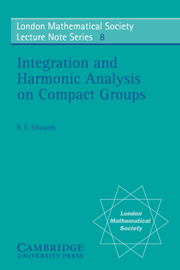Part 1 - Integration and the Riesz representation theorem
Published online by Cambridge University Press: 26 March 2010
Summary
Introduction to Part 1
A hint of the flavour of abstract harmonic analysis can (as is indicated in Edwards [4]) be transmitted as soon as a relatively primitive concept of invariant integration on groups is available; for the hint to get across, it suffices that one can integrate (say) continuous functions with compact supports. In order to make a more serious study, it is necessary (as was indicated loc. cit.) to have a more highly developed integration theory of the Lebesgue type. The major aim of Part 1 is to provide a brief account of one way of extending a primitive integration theory into such a Lebesgue-type theory.
This aim might be attained in any one of several ways. The chosen method might be said to be that which fulfils most expeditiously the secondary aim of exhibiting some aspects of the general role of integration theory in functional analysis and abstract analysis in general. Since this role is to a large extent crystallised in the so-called Riesz representation theorem (RRT, for short), the selected approach to integration theory is accordingly the one which is dominated by the idea of viewing integration as a linear functional defined on a space of continuous functions. This approach is in opposition to accounts which (cf. 1.1 below) base integration on a given measure function: instead, the measure function is made to appear as a derivative concept.
No attempt will be made to present this approach in the most general setting possible; in fact, we shall assume (except in various ‘asides’) that the underlying space is compact and Hausdorff.
- Type
- Chapter
- Information
- Integration and Harmonic Analysis on Compact Groups , pp. 1 - 41Publisher: Cambridge University PressPrint publication year: 1972



